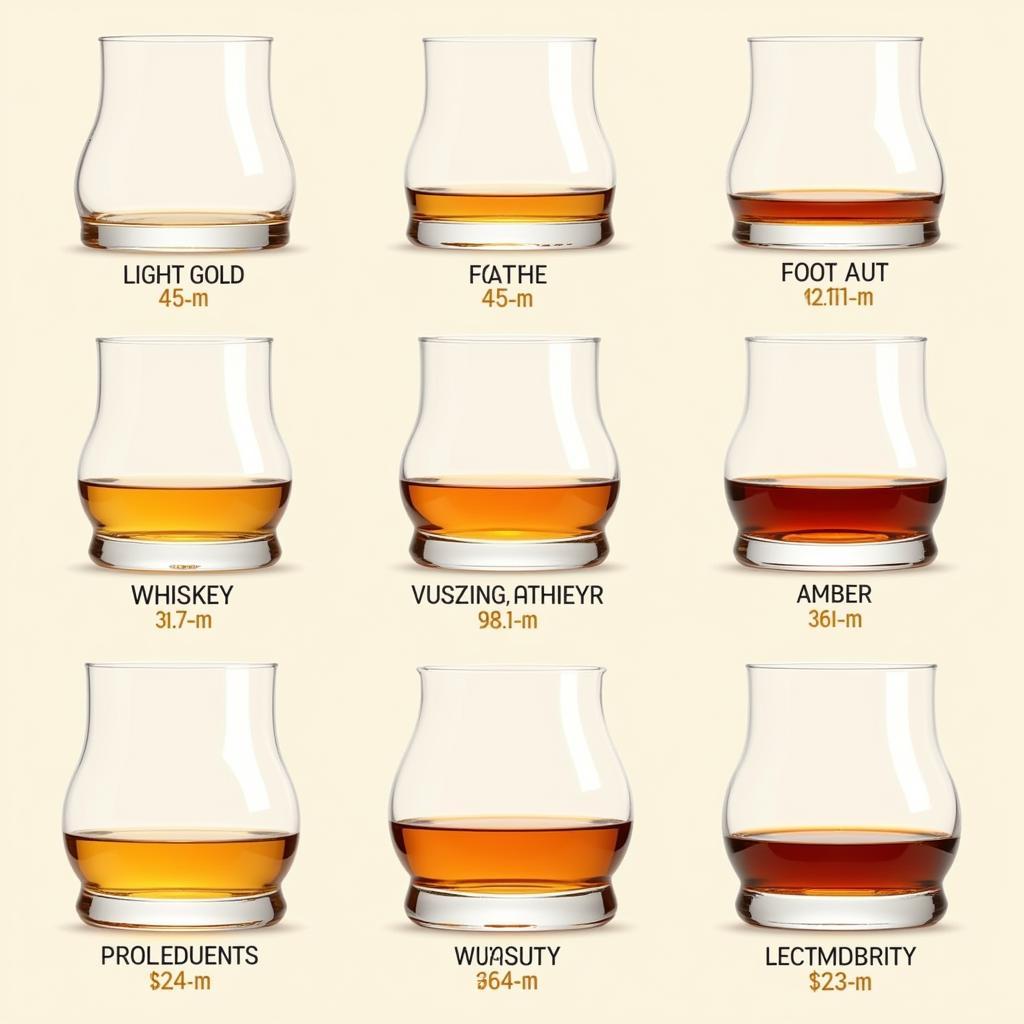Whiskey, a spirit enjoyed worldwide, is known for its complex flavors and alluring amber hues. But how does whiskey get its color? The answer isn’t as simple as you might think. It’s a fascinating journey involving several key factors, from the type of grain used to the aging process and even the barrel itself. Let’s dive into the secrets behind whiskey’s captivating color.
The primary source of whiskey’s color comes from the interaction between the spirit and the wooden barrels it matures in. These barrels, typically made of oak, impart color, flavor, and aroma compounds to the whiskey over time. The process isn’t instantaneous; it’s a gradual transformation that can take years, even decades, to achieve the desired result. What is Colorado famous for food? Discover more about the culinary delights of the Centennial State.
The Role of the Barrel in Whiskey Color
Oak barrels are essential to whiskey production. They are not merely storage vessels but active participants in the whiskey’s maturation. The wood itself contains various chemical compounds, including tannins, lignins, and other color-inducing substances. As the whiskey rests in the barrel, these compounds slowly leach into the liquid, gradually changing its color from a clear, almost water-like appearance to the familiar shades of gold, amber, and even deep mahogany.
The type of oak also plays a crucial role. American oak, commonly used for bourbon, tends to impart sweeter, vanilla, and caramel notes along with a reddish-brown hue. European oak, often used for Scotch whisky, contributes spicier, nutty, and dried fruit flavors, often resulting in a more golden or amber color.
 Whiskey Barrel Aging Process
Whiskey Barrel Aging Process
The Influence of Time and Charring
The length of time whiskey spends in the barrel is a critical factor in its final color. The longer the maturation period, the more intense the color typically becomes. This is because the whiskey has more time to interact with the wood, extracting more of its color and flavor compounds.
The charring level of the barrel’s interior also influences the color. Barrels are often charred using fire, creating a layer of charcoal inside. This charring process not only filters impurities but also contributes to the whiskey’s color and flavor profile. A heavier char can lead to darker colors and richer, smokier flavors.
Beyond the Barrel: Other Factors Affecting Whiskey Color
While the barrel is the primary influence on whiskey’s color, other factors can contribute to the final hue. The type of grain used in the mash bill can have a subtle effect, with rye whiskeys sometimes displaying a slightly spicier, reddish tint. Can you put food coloring in alcohol? Learn more about the effects and safety considerations of adding colorants to alcoholic beverages.
The addition of caramel coloring (E150a) is also permitted in some whiskeys, particularly in certain styles of American whiskey. This practice is somewhat controversial, as some argue it masks the true color derived from the barrel aging process. However, it’s important to note that the amount of caramel coloring allowed is typically quite small and primarily serves to standardize the color within a specific brand or batch.
Why Does Whiskey Color Matter?
While color doesn’t directly dictate flavor, it provides visual cues that can influence our perception of the whiskey. A deep amber color often suggests a richer, more mature spirit, while a lighter golden hue might hint at a younger, lighter-bodied whiskey. Ultimately, the color is part of the overall sensory experience of enjoying this complex and fascinating spirit.
 Whiskey Color Variations
Whiskey Color Variations
Conclusion: A Symphony of Wood, Time, and Grain
So, how does whiskey get its color? It’s a complex interplay of factors, primarily the interaction between the spirit and the oak barrel during maturation. The type of oak, the charring level, and the length of aging all contribute to the final hue, creating the captivating colors that whiskey enthusiasts admire. While color provides visual clues, remember that it’s just one piece of the puzzle. The true beauty of whiskey lies in its intricate tapestry of flavors and aromas.
FAQs
-
Does darker whiskey mean it’s older? Not necessarily. While longer aging often leads to darker colors, other factors like barrel char and wood type also play a role.
-
Can you tell the quality of whiskey by its color? Color is not a reliable indicator of quality. Flavor and aroma are better indicators of a whiskey’s quality.
-
Why are some whiskeys lighter in color than others? The type of oak, charring level, and aging time all influence the final color. Some whiskeys are intentionally aged for shorter periods, resulting in lighter hues.
-
Is caramel coloring always added to whiskey? No. While permitted in some styles, particularly American whiskey, it’s not a universal practice. Many whiskeys derive their color solely from the barrel.
-
Does filtering affect whiskey’s color? Chill-filtering, a process used to remove certain compounds that can cloud whiskey in cold temperatures, can sometimes slightly lighten the color.
-
Do all whiskeys age in oak barrels? While oak is the most common, some whiskeys are experimented with other wood types, which can influence the color.
-
What is the natural color of unaged whiskey? Unaged whiskey, often called “new make” or “white dog,” is typically clear and colorless, similar to vodka or gin.
Further Exploration
You might also be interested in learning more about the different types of whiskey, the distilling process, or the history of this beloved spirit. Explore other resources to deepen your understanding of the world of whiskey.
Need Help with Your Color Choices?
Need help bringing your own colorful vision to life? Contact Color Box Hanoi! We offer expert advice and top-notch services for all your painting and design needs. Reach us at 0373298888, email us at [email protected], or visit our showroom at 86 Cau Giay, Hanoi. Our 24/7 customer service team is always ready to assist you.
